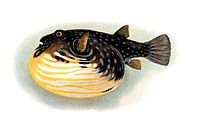
Matrotrophic viviparity constrains microbiome acquisition during gestation in a live‐bearing cockroach, Diploptera punctata
Sign Up to like & getrecommendations! Published in 2019 at "Ecology and Evolution"
DOI: 10.1002/ece3.5580
Abstract: Abstract The vertical transmission of microbes from mother to offspring is critical to the survival, development, and health of animals. Invertebrate systems offer unique opportunities to conduct studies on microbiome‐development‐reproduction dynamics since reproductive modes ranging… read more here.
Keywords: bearing cockroach; gestation; live bearing; cockroach diploptera ... See more keywords

The oviparous olm: Analysis & refutation of claims for viviparity in the cave salamander Proteus anguinus (Amphibia: Proteidae)
Sign Up to like & getrecommendations! Published in 2019 at "Zoologischer Anzeiger"
DOI: 10.1016/j.jcz.2019.05.004
Abstract: Abstract Accounts in the zoological literature commonly state that the European cave-dwelling “olm,” Proteus anguinus, can reproduce “facultatively” -- switching between oviparity and viviparity according to environmental circumstances. This paper evaluates the widespread allegations of… read more here.
Keywords: anguinus; oviparous olm; analysis refutation; olm analysis ... See more keywords

Common lizards break Dollo's law of irreversibility: Genome-wide phylogenomics support a single origin of viviparity and re-evolution of oviparity.
Sign Up to like & getrecommendations! Published in 2018 at "Molecular phylogenetics and evolution"
DOI: 10.1016/j.ympev.2018.05.029
Abstract: Dollo's law of irreversibility states that once a complex trait has been lost in evolution, it cannot be regained. It is thought that complex epistatic interactions and developmental constraints impede the re-emergence of such a… read more here.
Keywords: evolution; law irreversibility; oviparity; viviparity ... See more keywords

Ovaries and oogenesis in an epizoic dermapteran, Hemimerus talpoides (Dermaptera, Hemimeridae): Structural and functional adaptations to viviparity and matrotrophy.
Sign Up to like & getrecommendations! Published in 2017 at "Zoology"
DOI: 10.1016/j.zool.2017.08.001
Abstract: The Dermaptera are traditionally classified in three taxa: the free living Forficulina and two viviparous (matrotrophic) groups, the Hemimerina and Arixeniina. Recent molecular and histological analyses suggest that both matrotrophic groups should be nested among… read more here.
Keywords: oogenesis epizoic; ovaries oogenesis; hemimerus; epizoic dermapteran ... See more keywords

Phylogenetic position of a bizarre lizard Harpesaurus implies the co-evolution between arboreality, locomotion, and reproductive mode in Draconinae (Squamata: Agamidae)
Sign Up to like & getrecommendations! Published in 2020 at "Systematics and Biodiversity"
DOI: 10.1080/14772000.2020.1795741
Abstract: Viviparous reproduction has evolved independently more than 100 times in the evolutionary history of Squamata (lizards and snakes). Adaptation to cold climates is the dominant hypothesis explaining shifts to viviparity, but viviparous species are also… read more here.
Keywords: evolution; locomotion reproductive; evolution arboreality; harpesaurus ... See more keywords

Phylogenetic analysis of maximal oxygen consumption during exercise (V̇O2,max) and ecological correlates among lizard species
Sign Up to like & getrecommendations! Published in 2020 at "Journal of Experimental Biology"
DOI: 10.1242/jeb.229013
Abstract: ABSTRACT The maximum amount of oxygen consumed during forced exercise (V̇O2,max) sets the upper limit to the effort that can be sustained over relatively long periods and can limit activity levels in nature. Among ectotherms,… read more here.
Keywords: oxygen; viviparity; max ecological; max ... See more keywords